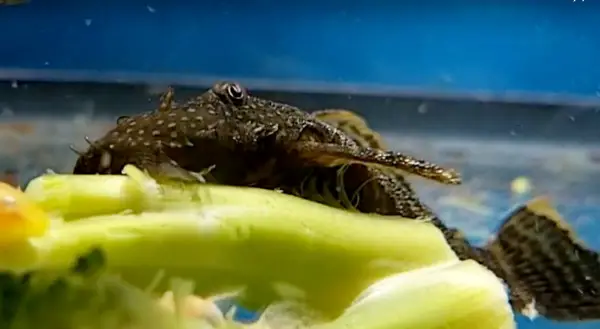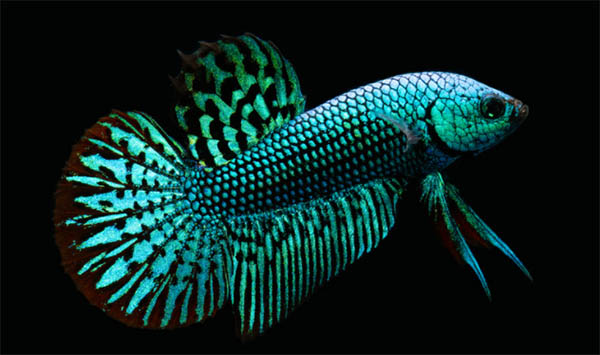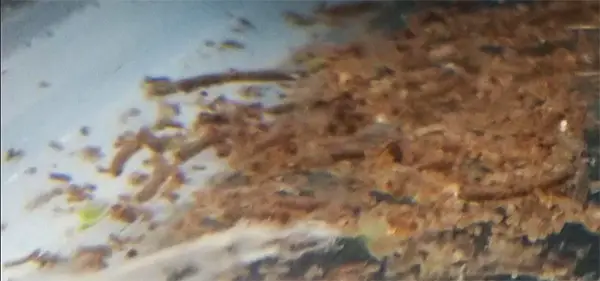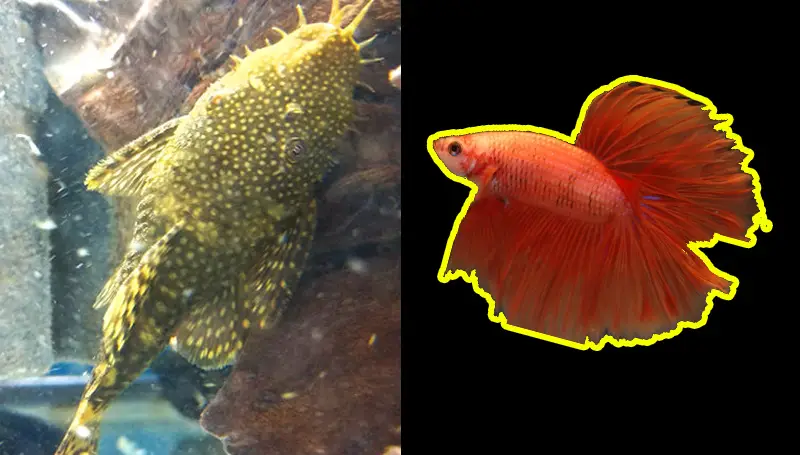Bristlenose plecos and betta fish, are they good tank mates?
Betta fish, especially the long-finned fancy variety, can be slow swimming, delicate fish. So, it can be challenging to find good tank mates for them.
But, some fish are just fantastic tank mates to almost any other fish. So, betta fish keepers, let me introduce you to one of the hobby’s “perfect” tank mates: the bristlenose pleco.
What Exactly Are Bristlenose Plecos?
Bristlenose plecos are a member of the loricariid family. Members of this family are commonly known as plecos because one of the early loricariids to enter the hobby was a fish scientifically named Plecostomus plecostomus. As you can imagine, that was a mouthful, so hobbyists shortened Plecostomus plecostomus to just “pleco” in parts of the world and sometimes “plec” in places like the UK. The name was slapped onto different members of the loricariid family as they were discovered and introduced to the hobby.

Loricariids are armored catfish. This means that their scales have evolved to form tough, thick defensive plates that cover their bodies. This causes the fish to have restricted movement. Which, when it comes to betta fish and other delicate aquarium fish, is what makes plecos such good tank mates! Because they can’t harm other fish even if they wanted to! They’re just kinda awkward in the way they move.
In addition to armor, another key feature of a pleco is its sucker mouth. This specialized mouth allows the fish to latch onto surfaces and eat whatever is growing on that surface. They’re often called “algae eaters” because of this sucker mouth. However, that is a misnomer because they don’t just eat algae, they eat “biofilm” which includes lots of other matter and organisms that accumulate on aquatic surfaces. Furthermore, some types of plecos use their sucker mouth to consume carrion (i.e. they scavenge on dead fish and other dead animals).
Where Do Bristlenose Plecos Come From?
Bristlenose plecos come from South America, as do most loricariid species. While, some species of loricariid range as far north as Panama.

Additionally, some pleco species have established themselves in other locations around the world. For example, in Florida there is a problem with a large population of invasive common plecos.
What’s So Good About Bristlenose Plecos? Size!
Well, unlike the common pleco, the bristlenose pleco doesn’t get that big. It can get as big as eight inches (20cm) but, it rarely exceeds six inches (15cm). So, while it will be significantly bigger than your betta fish, it won’t be a three foot monster like a common pleco!
What Else? Well, The Bristlenose Pleco Is Pretty Chill
In fact, the bristlenose pleco is more than just “pretty” chill. It is totally docile when it comes to heterospecifics (i.e. different species of fish). What that means is that bristlenose plecos can sometimes squabble among themselves, but that is usually only between males. Whereas, when it comes to other fish–like your betta–it will totally ignore them.

Also, while males will fuss with each other, because of their sucker mouths and rigid bodies, they generally won’t be able to do any harm to each other.
But, most importantly to betta owners, a bristlenose pleco will never, ever hassle your betta fish.
Should You Get One Or More Bristlenose Plecos?
Putting tank size aside, there are some other considerations before purchasing multiple bristlenose plecos.
First among your concerns should be the fact that two male bristlenose plecos will squabble with each other. While they won’t be able to do serious harm to each other, they will dart around the aquarium in a rambunctious manner.

Additionally, if you obtain male and a female bristlenose pleco, they will also engage in chasing as they reach adulthood and prepare to breed. And breed they will! Bristlenose plecos are some of the easiest aquarium fish to breed. All they need is a cave to breed inside of. You might not think you have a “cave” in your aquarium, but resourceful bristlenoses will usually find a cave of some sort to breed in. It might be inside that skull ornament you bought at Petsmart, or it could be on the underside of a piece of driftwood.
Will Bristlenose Plecos Breeding Be A Problem For My Betta Fish?
Worry not, unlike cichlids and anabantids, bristlenose plecos generally aren’t able to harm your other aquarium fish while they are breeding. So, in that sense, breeding bristlenose plecos provide no risk factors to your betta fish.
However, in a wider sense, breeding bristlenose plecos can be a problem. Younger pairs will start by producing around 40-50 young (this will increase with future clutches as the mother grows in size). So, suddenly adding 50 more fish to your aquarium will put a sudden and large bioload on your fish tank.
So, with water quality being so important, you might want to avoid allowing your bristlenose plecos to breed in your betta tank. Especially if it is on the smaller side.
The best way to prevent bristlenose plecos from breeding is to just buy one of them.
Yes, you can also keep single sex groups, i.e. all female or all male. However, it is difficult to tell juvenile male and female bristlenose plecos apart. Once they are sexually mature it is easier, though. The male has fleshly appendages (“bristles”) on his nose, whereas the female has none. Also, the female has a rounder, plumper shape to her body.
Bristlenose Plecos Will Eat Algae
Bristlenoses (sometimes known as bushynose plecos) will eat algae. Especially the younger fish, they will clean a tank clear of algae in a flash. However, as the fish ages, it will show less interest in algae.
Can A Bristlenose Pleco Live On Algae Alone?
Absolutely not. This is one drawback of keeping bristlenoses with your betta fish. A bristlenose pleco will need different food to your betta.
So, you might be wondering, what food will you need to add to keep your bristlenose happy and healthy? Well, you have a lot of options. Many manufacturers produce commercial “algae” wafers. While they are known as algae wafers, they tend to be compromised of a blend of beneficial ingredients that will keep your bristlenose pleco healthy.
In addition, you can actually give your bristlenose pleco veggies directly. Mine love green beans. Aquarium hobbyists favor green beans because a) they’re usually very cheap, b) they come canned, and c) you can throw them in a sealed plastic container and store them in the fridge for a week or so. Therefore, this makes green beans cost effective.
I have an in-depth article on what to feed bristlenose plecos here—check it out if you do decide to pair up your betta fish with a bristlenose pleco.
Plecos Produce A LOT Of Waste
Plecos are famous. Famous poopers that is!

All species of pleco (i.e. loricariids) produce a lot of fecal matter. So, if you do decide to go with a bristlenose pleco, bear in mind that it’ll significantly increase the amount of maintenance you’ll need to do on your aquarium.
Want A Pleco With Your Betta? Then Grab A Good Gravel Vac
A gravel vac will allow you to suck up your aquarium’s gravel substrate and, ultimately, pull the detritus from the gravel bed and then siphon it out of the tank. So, if you plump for a pleco, make sure you have a gravel vac you enjoy using, because you will be using it more often!
But, it’s not just poop you need to think about. If you have a pleco and, as discussed above, you feed it veggies directly, then you’ll need to cope with that waste too. Commercial fish foods are design to not be messy, but nature doesn’t care about cleanliness. So, fresh veggies are going to make a big mess in your betta tank. So, that’s another reason to have the gravel vac ready: suck up the excess vegetable matter floating around your aquarium.
Why Bristlenose Plecos? Why Not One Of The Other Species?
Bristlenose plecos are super popular aquarium fish for a good reason. As mentioned above, they’re small and chill. But, a lot of pleco species are small and chill, right? That’s true, but there are other reasons to favor a bristlenose pleco over a different species of pleco.
Price, Price, Price
I mentioned it above, but bristlenose plecos breed like rabbits. This means that they’re always readily available in the hobby. And that excess supply, you’ll remember from high school, means low, low prices! At the time of writing, I wouldn’t expect to pay more than $5 (US!) for a standard colored bristlenose pleco. Bear mind mind: prices for different varieties (e.g. albino, longfin, or green dragon) will be higher though.
Straightforward Diet
While they do need green matter in their diet (whether that’s commercial wafers or fresh veggies), their dietary needs are something that is generally well understood in the hobby.

I point this out because some of the more exotic and less common pleco species aren’t as well understood. For example, aquarium hobbyists often speculate over and struggle with what to feed certain species of pleco; for example, some need protein in their diet, while others depend on driftwood.
Don’t Forget The Driftwood!
It’s true that bristlenose plecos are not exclusive wood eaters, but they still need wood in their diet. This is because it is an essential part of their digestive process. It is believed that the bacteria in the biofilm that generates across wood is beneficial to their gut.
Bristlenose Plecos Are Usually Locally Bred By Fellow Aquarium Hobbyists
Because bristlenose plecos are so incredibly easy to breed, as we’ve mentioned several times, your local fish store is probably stocked with locally bred fish. Whereas, most aquarium fish are flown in long distances, often from overseas. This is important to know because a) locally bred fish are less stressed because they haven’t been on a long journey to the store and b) they are born and bred in (probably) the same tap water you use. This means they will be instantly accustomed to your water and will settle in with ease!
Benefits Of Selective Breeding – Hardiness & Tolerance
Additionally, it’s not just being locally bred that makes bristlenose plecos easy to keep. It’s also that they have been selectively bred for a long time. That selective breeding, generation by generation, gradually makes fish better accustomed to life in captivity. Whereas, generally speaking, wild caught fish are much more difficult to keep in typical tap water.
So, that is why bristlenose plecos have an advantage, healthiness-wise, over other pleco species. If you have ever kept any of the wild caught or wild type betta fish then you might already be familiar with this.
Benefits Of Selective Breeding – Different Varieties, One Species
Just like with your betta fish, selective breeding has also been used to breed for a variety of different mutations in bristlenose plecos. For example, albino bristlenose plecos are common. So, too, are long finned bristlenose plecos. Just imagine, you can pair up your elegant long-finned male betta with a similarly long-finned bristlenose pleco—what an aesthetic!
Benefits Of Selective Breeding – “Friendliness”
Goldfish are the oldest domesticated pet fish. We’ve been keeping goldfish as pets for thousands of years, and it shows. If you’ve ever observed goldfish in an aquarium, you’ll notice that they are happy to swim up to the glass and engage with you when feeding time comes. Betta fish have also been kept in captivity for a long time, so they too can be quite friendly with their owners.

Meanwhile, most other aquarium fish, and especially those recently introduced to the hobby, are much more timid.
So, this is another reason why bristlenose plecos make better “pets” than lots of other exotic pleco species. My own bristlenose plecos are not frightened of me when I come near the aquarium, and they are happy to rush out and eat the green beans I drop into the aquarium. When I’ve kept less common species, they often will hide most of the time and I can go days without even seeing them!
Good Alternatives To Bristlenose Plecos
That being said, if you don’t like the look of bristlenoses then there’s not much I can do to sell you on them. So, let’s think about some of the alternatives to bristlenose plecos.
Zebra Pleco
Zebra plecos are highly sought-after, expensive, exotic plecos that reach around three and a half inches in size (around 9cm). So, while bristlenoses are small, zebra plecos are significantly smaller still! This makes them a better option, size-wise, to be paired up with your betta fish. Furthermore, their striking black and white coloration could be seen as more desirable than the brown with light spots of the bristlenose pleco.
Queen Arabesque Pleco
The queen arabesque pleco is in the same genus as the zebra pleco (hypancistrus) and it shows, because it also has a dark and light zebra-like stripe pattern. However, the queen arabesque pleco has smaller, more intricate lines. Generally speaking, the queen arabesque pleco is cheaper than its zebra pleco cousin. Also, this pleco grows to around the same size as the zebra pleco.
Rubber Lip Pleco
The rubber lip pleco, submitting to subjectivity, is less attractive than both the arabesque and the zebra pleco. It is a light brown/gray color with dark spots. As the name suggests, it also has a distinctive looking mouth—it is large and looks sorta rubbery. Size-wise, the rubber lip pleco is closer to the bristlenose pleco as it grows to around seven inches (18cm). Also, the rubber lip pleco is more affordable than hypancistrus species. You can often see them for sale at big box pet stores.
Bad Alternatives To Bristlenose Plecos
While there are many, many more species of small pleco that make great companions for betta fish, there are also lots of species that make terrible tank mates for betta fish.
Bear in mind though, when we say a pleco species is a bad companion for a betta, we’re mainly operating on the assumption than your betta is in a small-ish aquarium, i.e. large pleco species need large tanks and so won’t be suitable for the average betta fish kept in the average betta fish size aquarium.
So, it could be that a large pleco species makes a good companions for betta fish if the betta fish was in a 90 gallon (340 liter) aquarium!
Common Pleco

The sale of the common pleco to novice aquarists at unscrupulous pet stores is one of the shames of our hobby. The common pleco grows to a size of 24 inches (approx. 60cm)! A two foot fish has no place in most casual fishkeepers modest home aquariums.
Panaque Species
The panaque species, particularly P. nigrolineatus, are admittedly beautiful. But, like their common cousin, they grow to a size unsuitable for the typical betta aquarium. Speaking of P. nigrolineatus, it grows to 17 inches (43cm), which makes it smaller than the common pleco, but still too big for a lot of fish tanks.
Leopard Cactus Plecos
The leopard cactus pleco is a total stunner! It has a beautiful leopard-like pattern with striking reddish-orange coloration on its dorsal and caudal fins. While this species is, like the previous two mentioned, too big for the average betta aquarium, it is a bit smaller than P. nigrolineatus. The leopard cactus pleco reaches about 13 inches (which is around 33cm).
Conclusion
So, in conclusion, I think bristlenose plecos are probably the best pleco for most betta fish owners. However, if you’re more ambitious then you could try some of the striking hypancristrus species like the zebra and queen arabesque plecos. Bear in mind though, plecos are messy eaters, require their own food, and poop a whole lot. So, a pleco isn’t going to clean your aquarium, it’s going to make you clean more! Bristlenoses will eat algae, but they’ll need more than just that.



